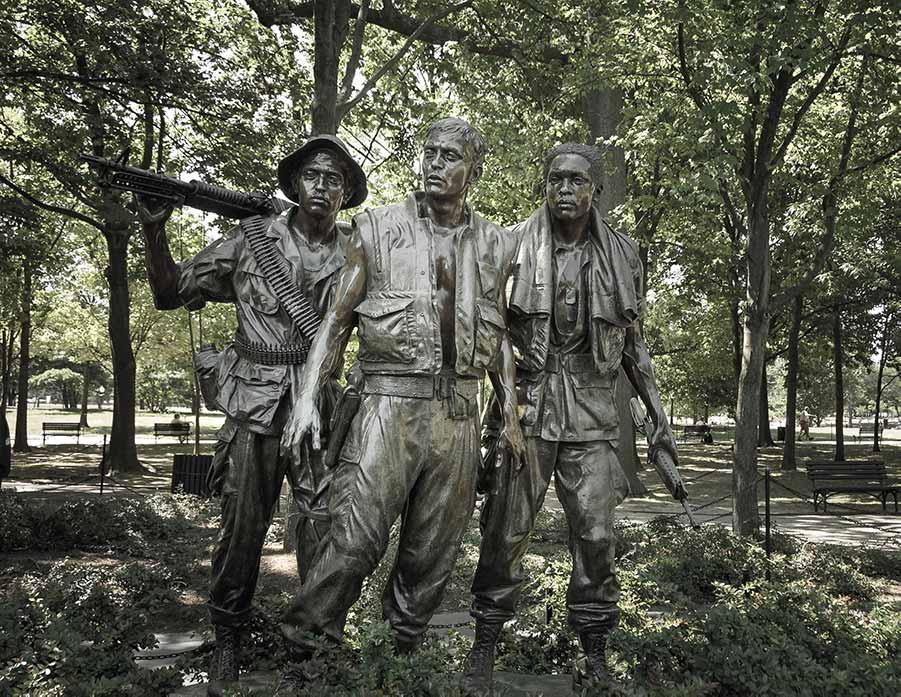In summary: the Vietnam War

With the interference of the US in the Vietnam War one wanted to stop the advance of communism. After 11 years and millions of Vietnamese dead and around 60,000 US soldiers killed, the war came to an end. Learn everything you need to know about the sad chapter in Vietnamese and American history. VIETNAM VISA ONLINE has researched for you!
The Vietnam War begins
When ideological tensions peaked in Vietnam in 1954, the country split into two states (North and South Vietnam). From then on, the Communist Viet Minh tried to reunite the south with the north, or rather put the south back under its own control.
At the same time there were political tensions between the USA and the Soviet Union (keyword: Cold War). The so-called Eastern Bloc speculated on the connection of other communist satellite countries. However, the US government saw a possible victory for the Viet Minh as a danger of a communist revolution. And so it happened that the Soviet Union – like China – supported the communist north of Vietnam, while the United States sent ground forces to South Vietnam. These troops were supposed to protect the country from the entry of the Viet Cong in 1965.
Additional knowledge of the Vietnam War
The Soviet Union did not send soldiers to Vietnam, but rather "only" supported the north with financial means etc. Just like the United States, the Soviet Union tried to expand its spheres of influence. This conflict of interests between the two nations took the form of a "proxy war" in Vietnam War.
The Vietnam war could have ended early
After the United States initially used only equipment and similar items in the south of Vietnam. and then also with ground troops (up to 500,000 men), President John F. Kennedy ordered the first air strikes against the Viet Cong in 1965. The bombings (25,000 in 1965) were intended to avert the impending defeat of the South in the Vietnam War. However, the Viet Cong acted in hiding and used the protection of the dense Vietnamese vegetation – the air strikes were hardly successful. That is why the US Air Force soon put its trust in the dreaded Napalm bombs.
Since this weapon did not achieve the hoped-for success, John F. Kennedy planned to withdraw US troops from the country. Before he could implement this project, he was murdered on the public street. This assassination called L.B. Johnson on the scene – the new president did not think of "buckling" in front of the Soviet Union and the Viet Cong. On the contrary: During Johnson's reign, the American presence in Vietnam War even increased.
Escalation with chemical agents
After the US base Camp Holloway near Plei Cu was attacked by North Vietnam, the Americans increasingly relied on the infamous defoliants Agent Orange. However, this herbicide did not only take cover from the Viet Cong: rice fields were destroyed, water reservoirs were poisoned, and the civilian population was thus deprived of the basis for their lives.
Another fact about the Vietnam
The North Vietnamese troops were hopelessly inferior to the US armed forces. The United States was never able to gain an advantage. Instead, the soldiers were ambushed more and more – a guerrilla war broke out.
The last breaths of Vietnam war
Between January 30 and September 23, 1968 there was a devastating Tet offensive through the north. This series of military operations did not bring a breakthrough to the Viet Cong either. On the contrary: The losses on the own side were immense (50,000 to 100,000 men).
Although military "success" was lacking, this offensive marked the beginning of the end of the war: shocked by the scale and horrific nature of the operations, the US Army leadership prepared to exit the Vietnam War. Military presence was increasingly reduced and in 1973 an armistice was negotiated with North Vietnam.
Since the south was now on its own, the Viet Cong fighters were soon able to take Saigon (= the capital of South Vietnam). On May 1st, 1975 – the communist north had won and the war was over.
A short summary of the Vietnam War
- July 21, 1954: At the Indochina conference, the division of Vietnam on the 17th latitude is decided.
- 1955–1964: A civil war breaks out in South Vietnam. This flows into the Vietnam War.
- August 5, 1964: The USA actively intervenes in the war.
- March 8, 1965: The first US ground forces land in Da Nang. Hanoi (North Vietnam's capital) speaks of an "open declaration of war".
- January 30, 1968: The Tet offensive begins.
- 1968 March: President Johnson is under pressure to start peace negotiations.
- October 31, 1968: Johnson announces the end of the bombing of North Vietnam.
- 1970 March: President Nixon has a decisive strike against North Vietnam examined (using nuclear weapons) and orders the invasion of neutral Cambodia. As a result, there is the largest anti-war demonstration in US history.
- 1972 March: The last US ground forces leave Vietnam. North Vietnamese troops advance to the south.
- January 1973: The negotiated peace agreement between North and South Vietnam is broken.
- April 30, 1975: The Viet Cong take Saigon, South Vietnam surrenders and the capital is renamed Ho Chi Minh City. The Vietnam War has ended.
Sad statistics: Between 55,000 and 60,000 US soldiers and two to three million Vietnamese (75 percent civilians) lost their lives in the war.
If you want to learn more about the history of this beautiful country, just apply for an online visa now and embark on the historical journey!
Created: 4/17/2020 | Modified: 6/20/2023
